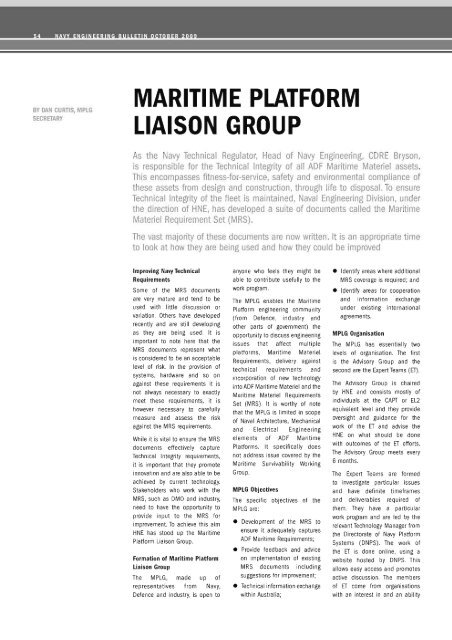ENGINE - Royal Australian Navy
ENGINE - Royal Australian Navy
ENGINE - Royal Australian Navy
Create successful ePaper yourself
Turn your PDF publications into a flip-book with our unique Google optimized e-Paper software.
BY DAN CU RTlS, M PLG<br />
SECRETARY<br />
MARITIME PLATFORM<br />
LIAISON GROUP<br />
As the <strong>Navy</strong> Technical Regulator, Head of <strong>Navy</strong> Engineering, CORE Bryson,<br />
is responsible for the Technical Integrity of all ADF Maritime Materiel assets.<br />
This encompasses fitness-for-service, safety and environmental compliance of<br />
these assets from design and construction, through life to disposal. To ensure<br />
Technical Integrity of the fleet is maintained, Naval Engineering Division, under<br />
the direction of HNE, has developed a suite of documents called the Maritime<br />
Materiel Requirement Set (MRS).<br />
The vast majority of these documents are now written. It is an appropriate time<br />
to look at how they are being used and how they could be improved<br />
Improving <strong>Navy</strong> Technical<br />
Requirements<br />
Some of the MRS documents<br />
are very mature and tend to be<br />
used with little discussion or<br />
variation. Others have developed<br />
recently and are stil l developing<br />
as they are being used. It is<br />
important to note here that the<br />
MRS documents represent what<br />
is considered to be an acceptable<br />
level of risk. In the provision of<br />
systems. hardware and so on<br />
against these requirements it is<br />
not always necessary to exactly<br />
meet these requirements, it is<br />
however necessary to carefully<br />
measure and assess the risk<br />
against the MRS requirements.<br />
While it is vital to ensure the MRS<br />
documents effectively capture<br />
Technical Integrity requirements,<br />
it is important that they promote<br />
innovation and are also able to be<br />
achieved by current technology.<br />
Stakeholders who work with the<br />
MRS, such as DMO and industry,<br />
need to have the opportunity to<br />
provide input to the MRS for<br />
improvement. To achieve this aim<br />
HNE has stood up the Maritime<br />
Platform Liaison Group.<br />
Formation of Maritime Platform<br />
Liaison Group<br />
The MPLG, made up of<br />
representatives from <strong>Navy</strong>,<br />
Defence and industry, is open to<br />
anyone who feels they might be<br />
able to contribute usefully to the<br />
work program.<br />
The MPLG enables the Maritime<br />
Platform engineering community<br />
(from Defence , industry and<br />
other parts of government) the<br />
opportunity to discuss engineering<br />
issues that affect multiple<br />
platforms, Maritime Materiel<br />
Requirements, delivery against<br />
technical requirements and<br />
incorporation of new technology<br />
into ADF Maritime Materiel and the<br />
Maritime Materiel Requirements<br />
Set (MRS). It is worthy of note<br />
that the MPLG is limited in scope<br />
of Naval Architecture, Mechanical<br />
and Electrical Engin eerin g<br />
elemen ts of ADF Maritime<br />
Platforms. It specifically does<br />
not address issue covered by the<br />
Maritime Survivability Working<br />
Group.<br />
MPLG Objectives<br />
The specific objectives of the<br />
MPLG are:<br />
• Development of the MRS to<br />
ensu re it adequately captures<br />
ADF Maritime Requirements;<br />
• Provide feedback and advice<br />
on implementation of existing<br />
MRS documents including<br />
suggestions for improvement;<br />
• Techn ical information exchange<br />
within Australia;<br />
• Identify areas where additional<br />
MRS coverage is required; and<br />
• Identify areas for cooperation<br />
and information exchange<br />
unde r existing international<br />
agreements.<br />
MPLG Organisation<br />
The MPLG has essentially two<br />
levels of organisation. The fi rst<br />
is the Advisory Group and the<br />
second are the Expert Teams (ET) .<br />
The Advisory Group is cha ired<br />
by HNE and consists mostly of<br />
individuals at the CAPT or EL2<br />
eq uiva lent level and they provide<br />
oversight and gu idan ce for the<br />
work of the ET and advise the<br />
HNE on what should be done<br />
with outcomes of the ET efforts.<br />
The Advisory Group meets every<br />
6 months.<br />
The Expert Teams are formed<br />
to investigate particular issues<br />
and have definite timeframes<br />
and deliverables required of<br />
them. They have a particular<br />
work program and are led by the<br />
relevant Technology Manager from<br />
the Directorate of <strong>Navy</strong> Platform<br />
Systems (DNPS). The work of<br />
the ET is done online, using a<br />
website hosted by DNPS. This<br />
allows easy access and promotes<br />
active discussion. The members<br />
of ET come from organisations<br />
with an interest in and an abi lity

















